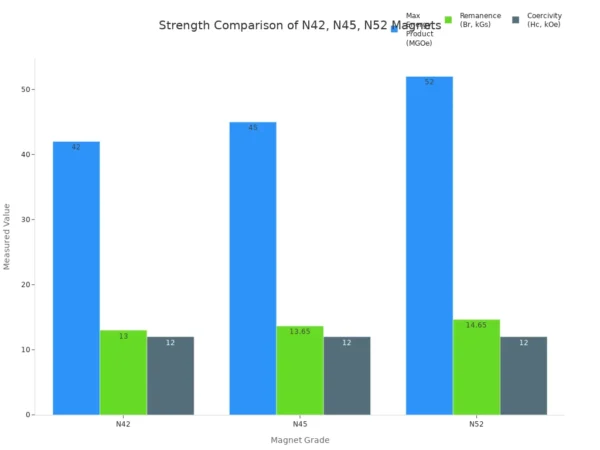Neodymium Magnets: Revolutionizing Modern Technolog and Industry
Neodymium magnets, also known as NdFeB magnets, are powerful permanent magnets made from an alloy of neodymium, iron, and boron. They are the strongest type of permanent magnets available and are categorized into different grades based on their magnetic strength, such as N35, N42, N52, N54 and N55.with higher numbers indicating stronger magnetic properties. These grades determine their suitability for various applications. Neodymium magnets have a wide range of applications due to their high magnetic strength. This article explores the primary uses of neodymium magnets, highlighting their significance in modern technology and industry.

Table of Contents
- Introduction
- Applications in Electronics and Electrical Appliances
- Uses in Motors and Generators
- Medical Applications
- Industrial Applications
- Conclusion
Introduction
Neodymium magnets are a cornerstone of modern technology, offering unparalleled magnetic strength and versatility. Their applications span various industries, from electronics to healthcare, demonstrating their critical role in advancing technology and improving efficiency. The strength and versatility of these magnets have led to their widespread adoption in numerous fields, revolutionizing how many devices operate and are manufactured.
Applications of Neodymium Magnets in Electronics and Electrical Appliances
Hard Disk Drives (HDDs)
Neodymium magnets are integral to the functionality of HDDs. They are used in the read/write heads to store and retrieve data efficiently, ensuring fast access and high storage capacity. The precision and reliability provided by these magnets are crucial for the performance of modern computing systems, enabling the rapid retrieval and storage of vast amounts of data.
Speakers and Microphones
In the audio industry, neodymium magnets are preferred for their ability to produce high-quality sound. They are used in the production of speakers, microphones, and earphones. These magnets help achieve superior audio performance by providing a strong magnetic field that enhances the movement of the speaker diaphragm, resulting in clearer and more precise sound reproduction.
Mobile Phones
Various components of mobile phones, including speakers and vibration units, rely on neodymium magnets for optimal performance. Their compact size and powerful magnetic field make them ideal for the slim and lightweight design of modern smartphones, contributing to better sound quality and more efficient vibration functions.
Neodymium Magnets in Motors and Generators
Electric Motors
Neodymium magnets are crucial in the development of electric motors used in electric vehicles (EVs), drones, and industrial machinery. Their strong magnetic fields improve motor efficiency and performance, leading to greater energy efficiency and reduced operational costs. In EVs, these magnets enable more powerful and efficient motors, contributing to longer driving ranges and better overall performance.
Wind Turbines
In wind turbines, neodymium magnets are used in generators to enhance efficiency, contributing to more sustainable energy production. These magnets help convert wind energy into electrical energy more effectively, making wind power a more viable and cost-effective renewable energy source.
Neodymium Magnets in Medical Applications
Magnetic Resonance Imaging (MRI) Machines
MRI machines utilize the strong magnetic fields of neodymium magnets to produce detailed images of the human body’s internal structures. These images are crucial for accurate diagnosis and treatment of various medical conditions. The strength and stability of neodymium magnets ensure high-resolution images, allowing for better detection and analysis of abnormalities within the body.
Neodymium Magnets in Industrial Applications
Magnetic Separators and Lifting Magnets
Neodymium magnets are employed in industrial separators to differentiate ferrous materials from non-ferrous ones in recycling and mining industries. They provide a reliable and efficient method for material separation, improving the quality and purity of recycled materials. Additionally, they are used in lifting devices to handle heavy metal objects, offering a safe and efficient way to move and transport large and heavy items in industrial settings.

Conclusion
Neodymium magnets’ strength and versatility make them indispensable in many modern technologies and industries. From electronics to healthcare and industrial applications, their impact is far-reaching and significant. As technology continues to evolve, the demand and utilization of neodymium magnets are expected to grow, further solidifying their essential role in various applications. The ongoing advancements in magnet technology promise even more innovative uses and improved performance in the future.

I’m Ben, with over 10 years in the permanent magnet industry. Since 2019, I’ve been with Osenc, specializing in custom NdFeB magnet shapes, magnetic accessories, and assemblies. Leveraging deep magnetic expertise and trusted factory resources, we offer one-stop solutions—from material selection and design to testing and production—streamlining communication, accelerating development, and ensuring quality while reducing costs through flexible resource integration.


